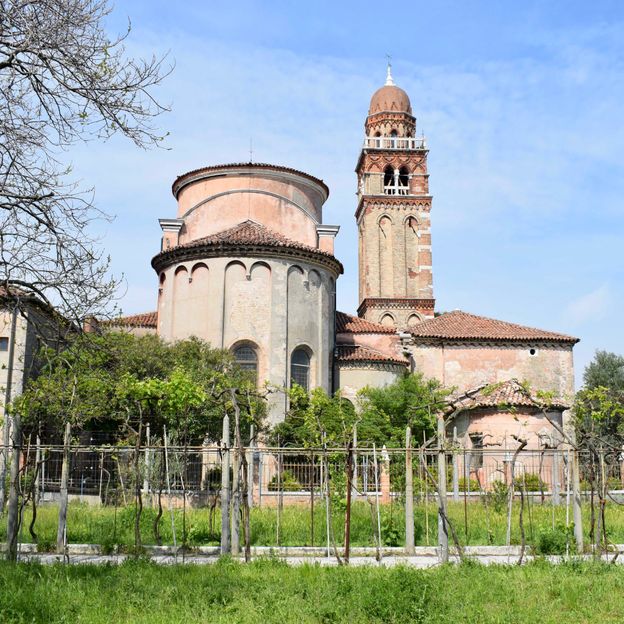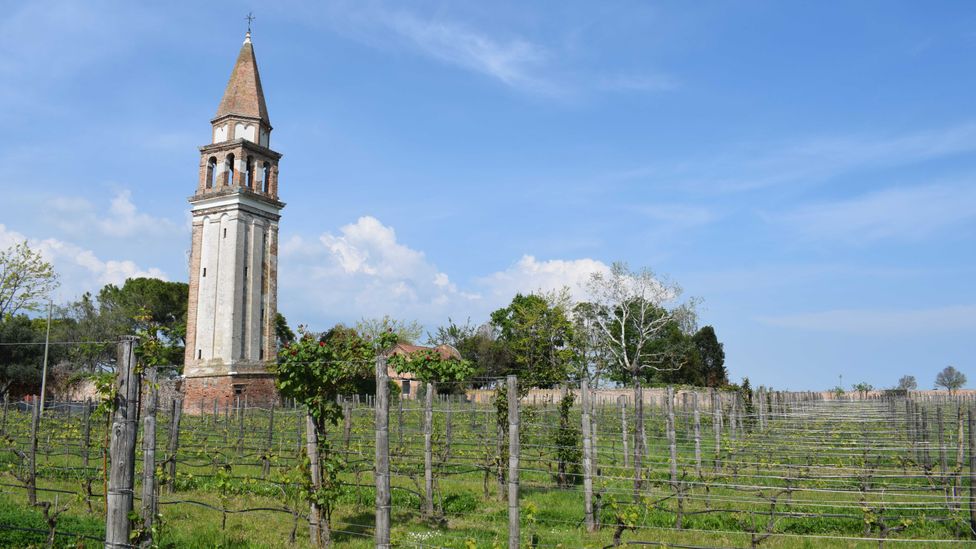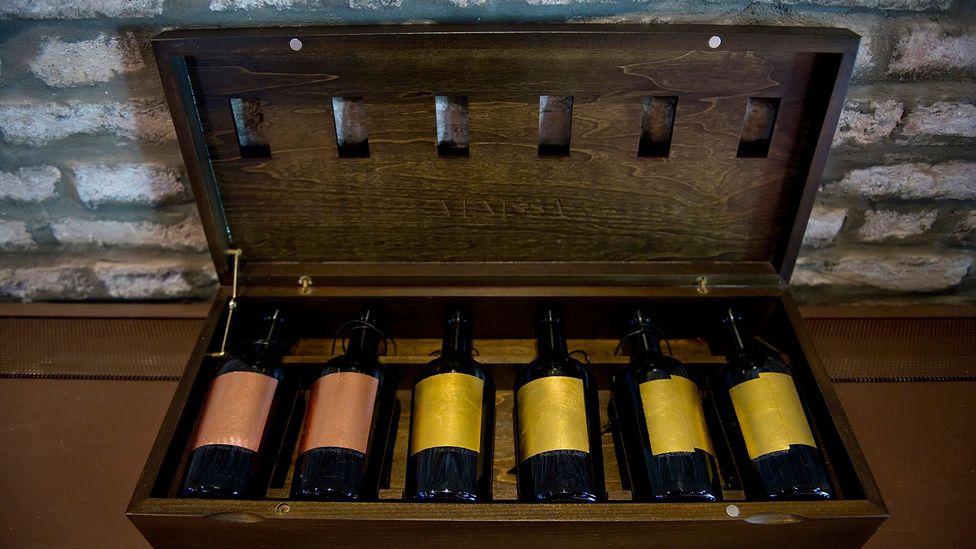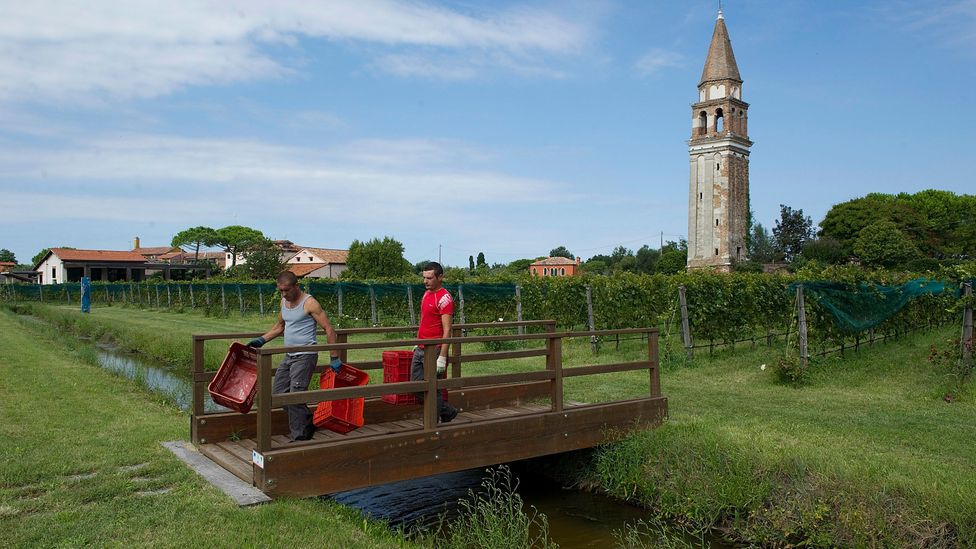In the garden of an abandoned monastery, on an ancient cemetery island in the Venetian Lagoon, I found myself surrounded by life. A man bustled past with a wheelbarrow full of brambles; two women sat on the ground, tending to flowering grapevines about to burst into fruit. Preparations were afoot on the Isola di San Michele for Venice's festival season, and Laguna nel Bicchiere, a non-profit organisation devoted to the propagation of Venetian viticulture, would be providing the wine.
"In late spring and early summer there are quite a few festivals," explained Colleen McCann, a long-time member of the organisation, as she showed me around San Michele's vineyard. "Each campo [city square] has its own different celebration, and on the solstice in June there's three days of festivities at the [Church of San Giovanni in] Bragora. We go there and offer people an ombra [small glass] of wine, with the idea being to let the city know about Venice's historical vineyards."
In addition to the vineyard we were standing in on San Michele, Laguna nel Bicchiere currently preserves three others – with origins going back centuries – on the Venetian islands of Giudecca, Sant'Elena and Vignole.

Laguna nel Bicchiere, an organisation devoted to the propagation of Venetian viticulture, preserves the vineyard on San Michele (Credit: Daniel Stables)
Laguna nel Bicchiere is not a commercial operation – they can't sell the wine, only give it away – and the vineyards are staffed by enthusiastic volunteers, motivated purely by the revival and preservation of Venetian winemaking. In the name of research, amid the mighty oak barrels of the monastery's cellar, I tried a couple of ombras myself. The wine was the colour of honey, rich and robust – tangibly imbued, even to my dilettante palate, with the salty taste of the lagoon.
Venetian winemaking has a long history that has been documented as far back as 2,500 years ago; until 1100, there was even a vineyard in the Piazza San Marco. That's despite the unique challenges associated with growing vines on islands prone to flooding, where saltwater lies just a few feet beneath the shallow earth. Stressed vines produce the best wines, though, according to winemaking wisdom, and this was certainly seen to be the case for Venice's indigenous dorona grape. The golden wine it produced was prized above all others by wealthy Venetians in centuries past, including by the doges – Venice's powerful heads of state.
"Archival research shows that the dorona was considered the doges' favourite variety because of its golden colour and the quality of the wine made from it – balanced and structured," said Valeria Necchio, a Venice-based food writer.
The dorona's dominance was not to last, however. "The diseases that spread across Europe at the turn of the last century – phylloxera, powdery and downy mildew – took a huge toll on the overall production and on the economy of the islands that were devoted to winemaking, like Mazzorbo, Sant'Erasmo and Le Vignole," said Necchio. "The workforce was redirected from fieldwork to factory work – for example, in the glass furnaces of Murano."

Venissa's vineyard is enclosed by ancient walls and towered over by a medieval bell tower (Credit: Daniel Stables)
The ease of importing wine from more reliable terroirs won out, and dorona wine was replaced on Venetian tables with those from elsewhere in Italy and beyond. In the 1950s and '60s, tourism came to further displace agriculture as the predominant industry in the lagoon. Then, most devastating of all, came a catastrophic high tide in 1966, which caused the worst flood in the history of Venice and drowned the few remaining vines. Venetian wine, along with the dorona grape itself, was a thing extinct, consigned to the history books.
Or so it was thought.
In 2002, local winemaker Gianluca Bisol was exploring the island of Torcello when he noticed an unusual golden grape gleaming on a gnarled vine in a garden beside the Byzantine Church of Santa Maria Assunta. "It was an accidental discovery, but when I saw those three dorona plants for the first time, a great emotion came over me," said Bisol. "It was immediately clear to me that they were different from any vines I'd seen before. Nicoletta, who looked after the garden, told me that indeed they were different – a native grape variety from the Venetian Lagoon. I was mesmerised."
Unsure if it could be true, Bisol arranged for DNA tests, which confirmed the grapes were indeed the storied dorona.
After poring over historical viticultural texts and scouring local vineyards and gardens, Bisol discovered a total of 88 surviving dorona vines on Torcello and the surrounding islands. A key player was Gastone Vio, a farmer on the island of Sant'Erasmo, who provided scores of dorona vines to the Bisol family and whose planting techniques had enabled the survival of his crop through the flood of 1966. "Thanks to the conversations and exchanges I had with other growers and winemakers working in the lagoon, I learnt more about what I had to face in order to bring back this time-honoured Venetian tradition – viticulture," Bisol said.

Honouring two more Venetian traditions, Venissa's hand-blown wine bottles display hand-beaten gold leaf (Credit: Awakening/Getty Images)
He learned how the vines needed to be planted far apart, to allow the roots to grow sideways to avoid the saltwater; and how wells had to be dug hundreds of feet deep to reach the fresh water needed to flush the vineyards. Bisol found a medieval monastery on the nearby island of Mazzorbo with a walled vineyard and put to work what he had learned. Ten years and much experimentation later, the first vintage of his Venissa wine was produced.
Gianluca's son, Matteo Bisol, now oversees operations at Venissa, and he met me off the boat to show me around Mazzorbo. In contrast to the tumbledown vineyards of San Michele, Venissa is a swanky commercial enterprise – a Michelin-starred restaurant and luxurious lodgings have been added to their portfolio in recent years. However, they share one of Laguna nel Bicchiere's fundamental principles. "We're really serious about the quality of the wine," Matteo told me. "But for us, it represents something way bigger: bringing back a part of the history of Venice to the lagoon after we almost lost this wine."
The rediscovery of the dorona has ignited a revival in Venetian wine. Laguna nel Bicchiere now grows a mixture of dorona and other, non-indigenous, grapes, and produces mixed-grape wines. Venissa's whites are made with 100% dorona grapes, and their vineyard is the only one dedicated solely to its commercial production. The limitations of the lagoon mean it will always remain a boutique enterprise; the estate produces 3,500 bottles per year, which are sold mainly in the immediate area.
Venissa's dorona wine has won acclaim for its full body and bold, dry taste, thought to be very similar – thanks to the dorona grape's unique profile and traditional, organic growing methods – to the wine so prized by the doges. It carries an unmistakable hint of saltiness, and pairs extremely well with the lagoon ingredients served in Venissa's restaurant, like oysters, lavender and Sant'Erasmo honey.

Drainage ditches cross Venissa's vineyards to combat the saltwater from the lagoon (Credit: Awakening/Getty Images)
As we wandered through the vineyards, Matteo pointed out a large canal dug between the vines to rid them of floodwater from the lagoon. Crouching down, he signalled towards some tiny tufts of green, gamely sprouting amid the vines. "This is a sea herb; this one's samphire; this is erba stella [buck's horn]. These three grow only in a salt environment. If we move a little bit higher" – he pointed a few inches to the left – "here we still see some of the sea plants, but we can also see the margarita [daisy]; this is a mixed area. If we go here, this is the freshwater version: normal land, not salt land, just a few inches away. It's all very stressful for the vine, but it's important for the quality of the wine that the vine needs to struggle. No pain, no gain."
That philosophy was tested to its limits this year, which marks another milestone in the dorona grape's proud history of near-extinctions and triumphant resurrections. "We were very afraid at the beginning of this current season, because the vines are still suffering from the 2019 high tide – the second biggest ever," Matteo said. The vines survived – just – but in 2021, they struggled even more than in 2020. "All plants keep substances in reserve, which they use to survive after difficult years; we didn't know at the beginning of 2022 if the vines would have enough to survive. We were very happy, because the grapes showed us their resilience once again."
Venetian wine is an improbability; but then, so is Venice itself. "For us, the dorona is a symbol," Matteo said. "Venice is really the struggle of the human being to create a city in the middle of a lagoon. Dorona, in this terroir, in this situation – it's a great metaphor for the genius of the Venetian people, who were able to create something amazing in a situation that was almost impossible."
BBC Travel's Forgotten Foods offers hope for the world's "lost" foods through chefs and purveyors who are bringing them back to life though cooking and cultivation.
--
Join more than three million BBC Travel fans by liking us on Facebook, or follow us on Twitter and Instagram.
If you liked this story, sign up for the weekly bbc.com features newsletter called "The Essential List". A handpicked selection of stories from BBC Future, Culture, Worklife and Travel, delivered to your inbox every Friday.
"fruit" - Google News
June 20, 2022 at 06:29AM
https://ift.tt/fDHUlby
The resurgence of Venice's prized dorona grape - BBC
"fruit" - Google News
https://ift.tt/eMh734P
https://ift.tt/ZcbBqEO
Bagikan Berita Ini














0 Response to "The resurgence of Venice's prized dorona grape - BBC"
Post a Comment